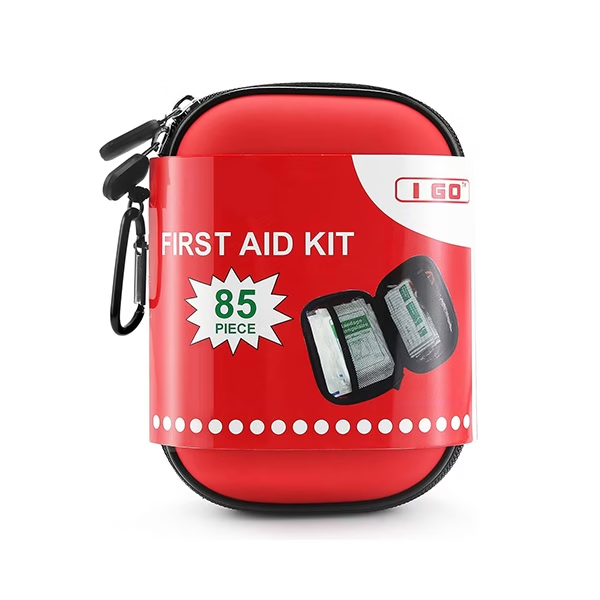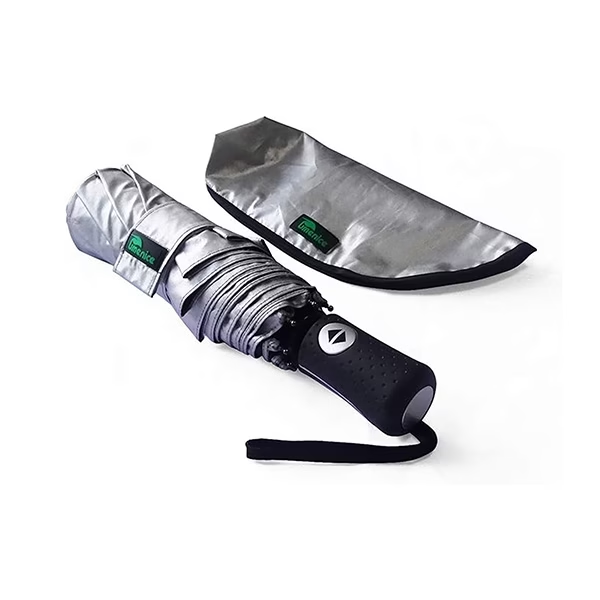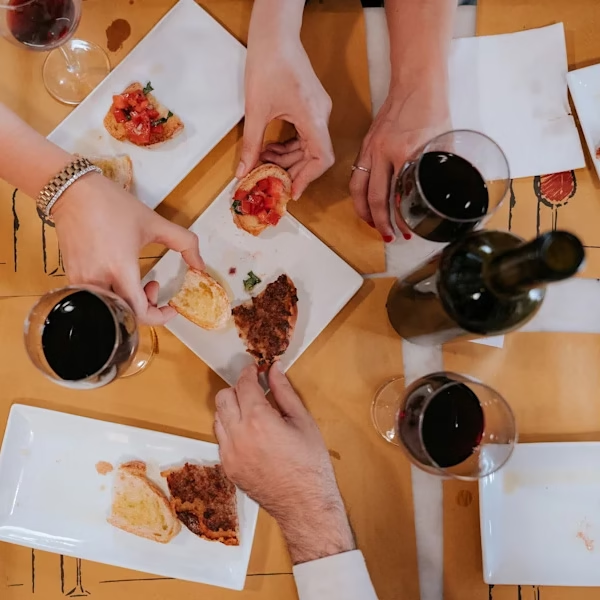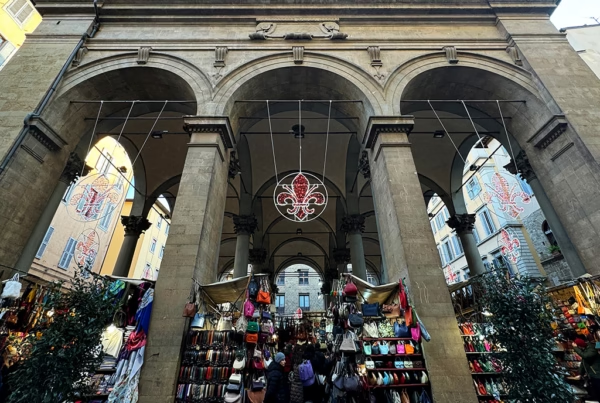The traditions of Florentine cuisine are based on all the wonderful produce that’s available here, which has shaped the food local people eat for generations.

Florentine cuisine is extremely varied, and extremely delicious
Wondering what to eat in Florence? Read on to find out.
Our Guide to Florentine Cuisine
Florence is not only a city of beautiful art and splendid architecture. It’s where bakers, cheese makers, and chefs are known across the world as masters of their work. So, one of the best Florence things to do is try all the local specialities.
Here I will tell you about Florence’s best culinary experiences, as well as the finest products of this Italian region that fill the city’s markets and trattorias, for the perfect accompaniment to all that sightseeing.
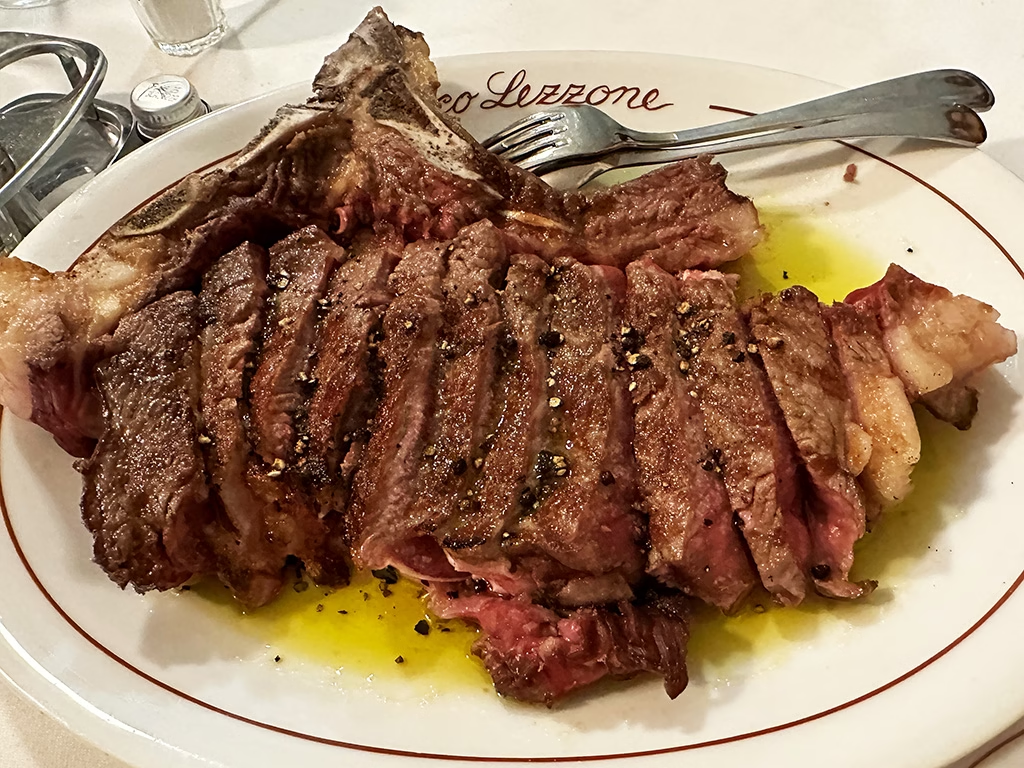
As good as the Florentine steak is, there’s a lot more to the Florentine cuisine to discover
On this page I will be covering:
- The historical basis of Florentine cuisine
- The ingredients that form the basis of Florentine cuisine today
- Some of the traditional dishes you should try when visiting Florence
- What pizza looks like in Florence
- Tuscan wines and grape varieties
- Florentine desserts and sweet treats
- What’s so special about the Florentine steak
Bear in mind while reading this page that trying to define Florentine cuisine is tough.
Also, having to pick some favorite Florentine dishes inevitably leaves out some other much-loved regional specialities, which the locals are very passionate about.
PREFERRED TOUR PARTNER

Explore Florence and Tuscany with a local expert on an exclusive private tour with Walks of Italy:
The Historical Basis of Florentine Cuisine
I spent the best years of my youth in Florence, and one thing I’ve always noticed is how excited Florentines get about their food and the passion they have for preparing it.
While wandering through local neighborhood markets, I couldn’t help noticing how people allowed butchers to choose the most suitable cut of meat for the meal they were planning, or how they engaged in endless chats with the greengrocer listening to his suggestions.
What I learned over time was that Florentine cuisine is still tied to the basic principle of using locally grown ingredients, which have also been processed locally.

Markets in Florence are all about fresh, seasonal produce
Historic Traditions
Traditionally Florentine cuisine has two distinct “ancestors”: the lavish cuisine of the aristocracy and the simple, popular fare of those less well-off – known as cucina povera, which translates roughly to “poor food.”
For the nobles and the Medici family who ruled Florence, food had to be a symbol of luxury and creativity. Huge banquets would be served with generous helpings of rich dishes, with increasingly ornate and clever displays of food and new recipes being displayed to show how powerful and rich they were.
Despite the history of these extravagant meals, most restaurants nowadays tend to offer dishes from the cucina povera tradition, which is what most Florentine and Tuscan people actually ate.
Organize your transport easily and stress-free for any trip to Florence and Tuscany:
Florentine Cuisine Ingredients
Today Florentine cuisine is synonymous with the art of good eating all over the world. But what is this based on?
Beans
There are many varieties of Tuscan beans eaten in Florence. Zolfino, toscanello and coco nano are some of the most popular beans from the Tuscan region, which boasts many recipes based on this legume in its culinary tradition.

A staple part of the Tuscan diet for centuries, beans are far more tasty in Florence than you might expect
Vegetables
There is an abundant array of vegetables at the heart of Florentine cuisine, following the seasonal availability of produce throughout the year.

I love getting a plate of simple grilled vegetables to go with my meal
Whenever you visit Florence, make sure to take at least one morning to explore the markets near where you are staying and see what Florence foods are on offer. This is also a fun thing to do if you’re traveling solo, as you can get exactly what you want.
Olives
Because of the climate, fertile land and skilled hands, Tuscan extra virgin olive oil has become one of the most popular Italian food products in and outside of Italy. Olives and olive oil have always been resources in Tuscany, evolving over time to gain ever greater qualities.
In 2000, the Tuscan Virgin Olive Oil was given DOP (Protected Designation of Origin) status, preserving the unique qualities of this essential Tuscan and Florentine ingredient.
PREFERRED TOUR PARTNER

Indulge in authentic Florentine and Tuscan cuisine on a food tour with an expert guide from Walks of Italy:
Unsalted Bread – Pane sciocco
Tuscan bread has been part of Florence’s cuisine since the dawn of time. Documents from the ancient Roman era relay how locals made bread out of wheat, casting their formed loaves onto the floor of brick ovens to be slow cooked. During the Middle Ages millers and bakers played an important role within the Florentine guilds due to the constant demand for Tuscan bread.

Bread is served with pretty much every meal in a restaurant, but the idea is to eat it with food, not by itself
Tuscan bread can be a surprise when you first taste it, because of the practice of making it without salt. Known as pane sciocco, whether it comes in loaves or flat-breads, the bakers work the dough without the use of additives that would make the job easier but result in a less tasty product.
Traditional bakeries in Florence proudly keep a simple recipe for their unsalted breads: soft wheat flour, type “0” with wheat germ, (an ingredient that has now disappeared in common flours) as well as natural yeast and water. That’s it!
Traditional Florentine Dishes
You should be able to find these dishes on most trattoria menus, and they are always worth trying.

Ribollita is one of the most well-known Tuscan dishes, but what others will you find on Florentine menus?
Ribollita
A favorite Florentine recipe for many people, Ribollita is a Tuscan bread soup, made with stale Tuscan bread, potatoes, cannellini beans, kale, tomatoes and the ever present olive oil.
There are endless variations with other hearty vegetables included, but these are the most important components. The name Ribollita comes from the way the ingredients are cooked; first all the ingredients are sauteed then they are stewed for hours, over low heat for super slow cooking.
Pappa al pomodoro
Another popular Florentine dish is Pappa al Pomodoro, a tomato soup made with stale bread (strictly Tuscan bread) basil, tomatoes, salt, pepper and of course, olive oil. Cooked down, all these ingredients combine to form almost a thick tomato stew, delicious and warming in the winter but I love it year-round.

Basic ingredients come together to create something super special in this Florence typical food
Fagioli all’Uccelletto
Any respectable restaurant in Florence wouldn’t dare to leave this appetizer off its menu. Fagioli all’Uccelletto is a dish of beans baked slowly, traditionally served in a crock pot. Enjoy them with thick slices of crunchy bread or as a side to your steak.

Many restaurants serve Tuscan beans as a side dish
A truly local food, it’s definitely worth trying for the ultimate comfort food.
PREFERRED TOUR PARTNER

Indulge in authentic Florentine and Tuscan cuisine on a food tour with an expert guide from Walks of Italy:
Toasted bread with chicken livers
The oldest Italian appetizer, the simple dish of chicken liver pate on bread is a very traditional Italian food and one of the best things to eat in Florence.
Tuscan bread has been toasted for centuries, served with a platter of cured meat and cheese, or just as appetizers, these bold toasted-breads have always been Florentine favorites which locals eat whenever they can.
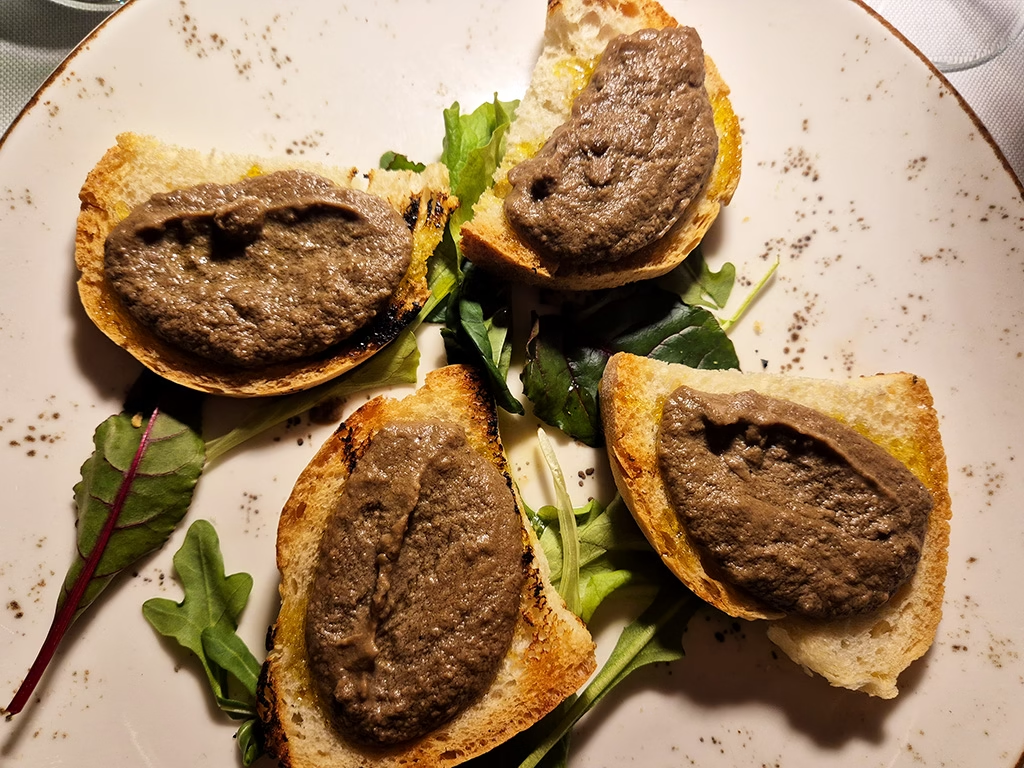
Simple but absolutely delicious
Nowadays restaurants tend to add more ingredients or shape the bread into thinner slices, as well as serving them with seasonal variations.
Gnudi dumplings
Literally meaning “naked”, gnudi or dumplings are another classic Tuscan cuisine dish. Stuffed pastas have been around since Medieval times.
They strictly belong to the ‘poor cooking’ tradition, with coarsely ground corn or chestnuts for the dough before the dumplings are shaped and stuffed with vegetables or a little leftover meat so as not to waste anything.
Over time, different versions of this tasty local dish have spread throughout the whole region, sometimes served in a tomato sauce, or with truffle shavings, or even just with melted butter.

The simplicity of gnudi makes for a deliciously light dish
Arista di Maiale
This is a classic Florentine meat dish, a tasty roast pork shank sirloin.
It’s said that in the 15th century, during a banquet arranged for a group of Greek dignitaries, this delicacy was so appreciated that the diners repeatedly asked for more rounds, shouting “Arista Arista”, which in Greek (άριστα) means “excellent, excellent”, and the word stuck.
The pork is baked in the oven with chopped rosemary, sage, salt, olive oil, and pepper, making it a really tasty main dish.
No matter when you visit Italy, here are some essential things we recommend never leaving home without:
Use the arrows or scroll to view all recommendations
What Pizza Looks Like in Florence
You may not think of pizza when deciding what to eat in Florence, but there is a variation specific to this area you should try during your visit.
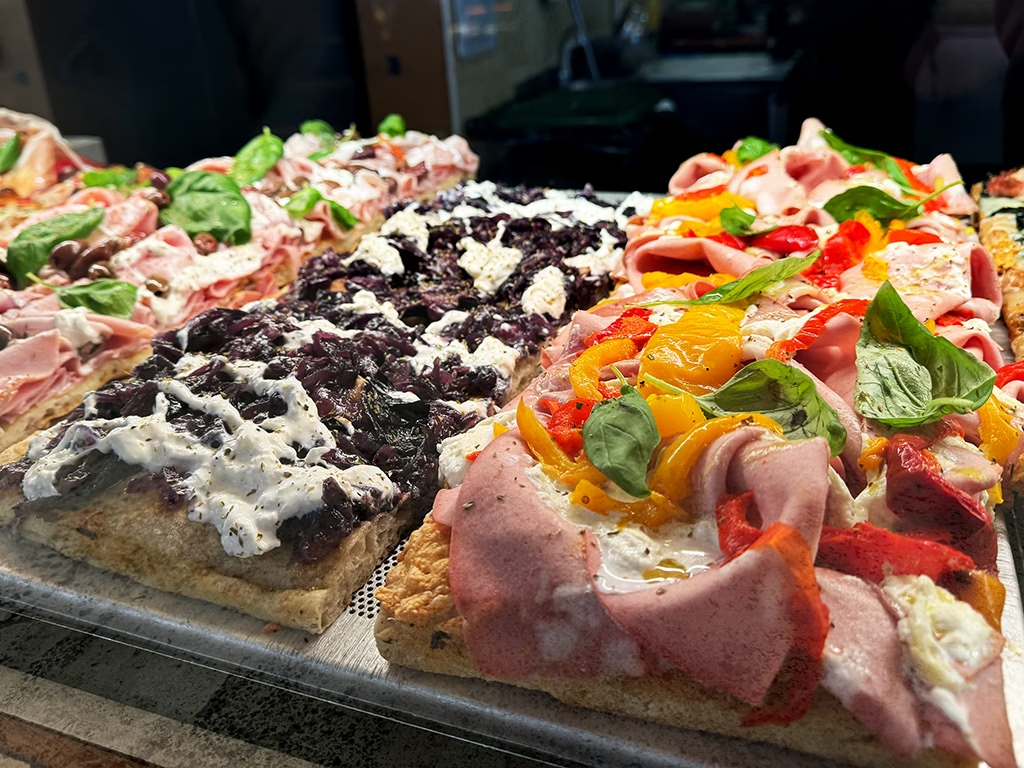
While Florence isn’t known for its pizza, you can still get a fantastic slice for a quick lunch or snack
La schiacciata
All over Italy, no matter where you go, sooner rather than later you’ll end up having some pizza by the slice. In Florence it’s called schiacciata (flat-bread) and is generally stuffed with ingredients rather than being topped with them.

The dedicated stall in Mercato Centrale is an excellent place to try schiacciata
As in Rome or Naples, this street food has a few strict guidelines (the dough, the flours used, the leavening time and the method, baked or fried), in Florence, we say that there are no rules because you can try many variations.
My favorites are la Favolosa, stuffed with sbriciolona toscana (a kind of Tuscan cured meat), pecorino cheese cream, artichoke-pate and spicy eggplant. Or la Boss, with prosciutto, pecorino cheese and truffle cream.
Tuscan Wines and Grape Varieties
Wine has been a part of Tuscany for more than 3,000 years, with long standing traditions which have heavily impacting the Tuscan culture. Tuscan wines are some of the most popular wines produced in Italy, and unarguably some of the very best on the planet.

Tuscan wines have something for everyone, with plenty of local varieties to choose from
Here are some of the most popular Tuscan grapes to look out for on wine lists and wine labels in Florence restaurants and bars:
Local white grape varieties
- Vernaccia di San Gimignano
- Canaiolo Bianco
- Trebbiano Toscano
- Grechetto
Local red grape varieties
- Malvasia Nera
- Ciliegiolo
- Aleatico
- Sangiovese
Florentine Desserts and Sweet Treats
Under the banner of “pochi ma buoni” or ‘fewer but really good’, Florence also excels in the field of patisserie. There are a wealth of bakeries scattered all around Florence, where pastry chefs deliver a generous helping of local delicacies.
Choose from time-honored traditions and over-the-top modern creations, where homemade pastries and cakes are baked fresh and dessert lovers are treated to decadent treats.

Taking a break from sightseeing with a coffee and piece of a delicious typical Florentine sweet cake is super easy in Florence
Neccio
Also called niccio or ciaccio, Neccio is a galette made with chestnut flour and stuffed with ricotta cheese, honey and dusted with powdered sugar.
Click to view the essential things you should always have when traveling:
Cantucci
These dry almond biscuits are known for being tasty, crunchy, and excellent when soaked in sweet wine, or Vin Santo, a classic Tuscan dessert wine.
They are cooked in the oven, then cut and toasted until they become crunchy and get a nice golden hazelnut color.

Cantucci served with vin santo is a very common dessert year-round in Florence
Zuccotto
On Tuscan tables for centuries, this simple cake of sponge is lightly soaked with Alchermes liqueur and comes in different versions. My favorite type to eat in Florence is one stuffed with ricotta cheese and candied orange zest, covered with dark chocolate.
Castagnaccio
Castagnaccio is a chestnut-flour cake with its origins dating back to medieval times. Peasants used everything that could give them energy and calories to survive the cold and help them work, and chestnuts were readily available to them.
While this is not a gourmet recipe, today it’s considered a classic. Among its ingredients very often are walnuts, grated oranges, pine-nuts and raisins.
Gelato
As in pretty much all Italian cities, Florence has a huge variety of places to get gelato, some great and some not so great. When choosing where to get your gelato fix, make sure to avoid anywhere with huge piles of brightly colored concoctions.

I can never have enough gelato, regardless of the time of year
PREFERRED TOUR PARTNER

Indulge in authentic Florentine and Tuscan cuisine on a food tour with an expert guide from Walks of Italy:
What’s so Special About the Florentine Steak?
Before I talk about the bistecca alla fiorentina, we need to talk about the tradition of eating meat in Florence.
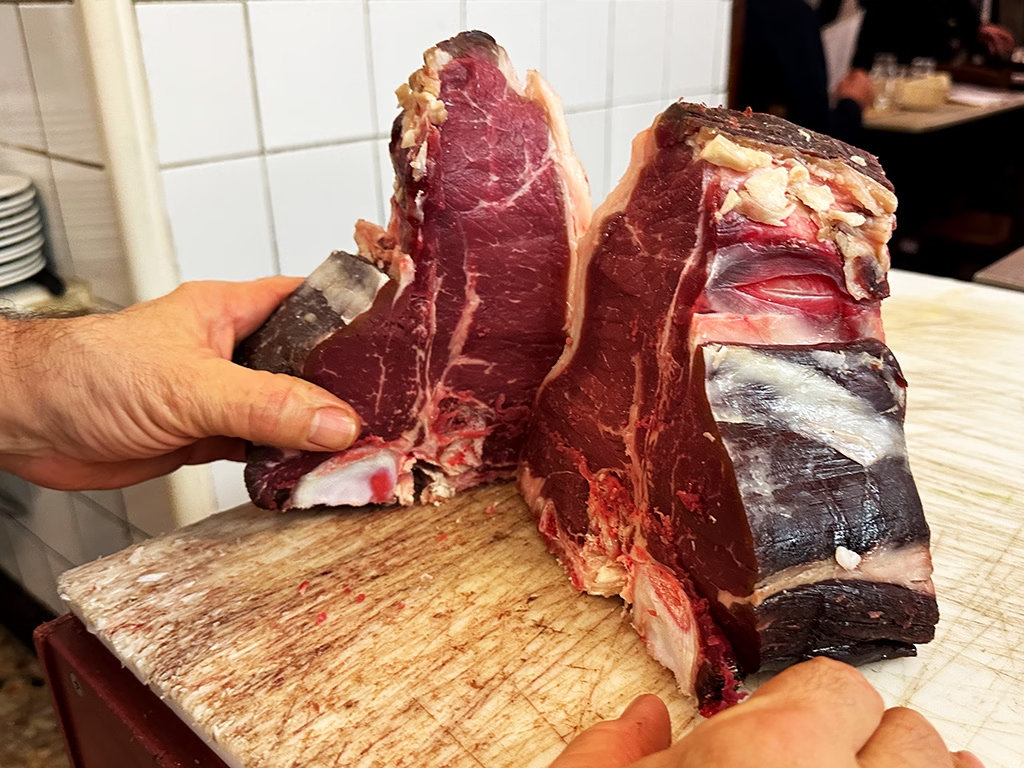
The iconic Florentine steak is absolutely delicious when cooked properly
Every part of the animal
The Tuscan hills are dotted with enchanting hilltop towns, green fields and cattle. Lots and lots of cattle. But until recently, access to the finest cuts of meat was not available for everyone.
The best pieces were reserved for the nobility, so most people had to choose from what was left of the animal. Regular Florentine people would go to their local butcher and choose from the off-cuts: kidney, spleen, liver, brain, tongue, tripe, intestine, tail, leg muscles and even the testicles.
To change these parts of the animal into edible food, strict rules had to be followed. The meat had to be cleaned carefully to avoid infections, cooked slowly to make the pieces tender with a skilful mixture of spices added to break down the strong flavors.
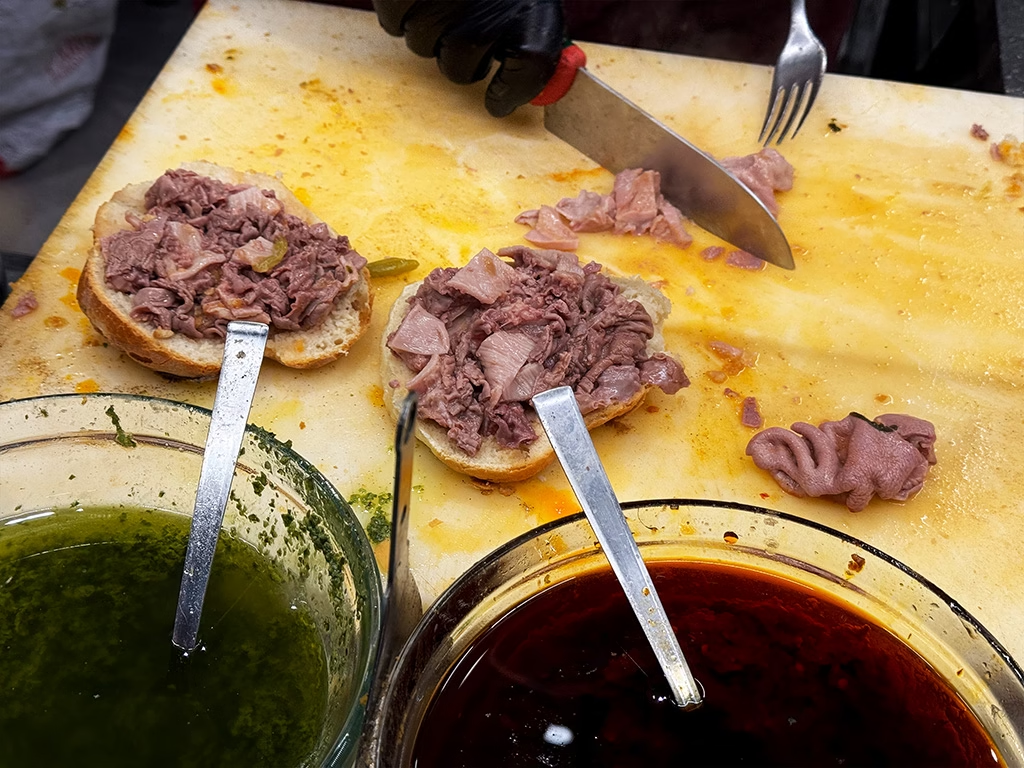
The tradition of Florentine lampredotto came from the custom of eating every part of the animal
As in other parts of Italy and Italian cities, in Florence the habit of eating offal both as street food and for a hearty meal has therefore been handed down over the centuries.
Today, some of these old dishes have taken the lead as gourmet slow-foods, panini filled with lampredotto or trippa alla fiorentina. These are definitely a bit unusual, and more for adventurous eaters, but I highly recommend giving at least one of them a try when in Florence.
Bistecca alla Fiorentina
I have deliberately left the ultimate steak for last. Commonly known as Bistecca alla Fiorentina, the t-bone steak you get in Florence is world famous.
For some, it’s about a family-run restaurants. For experts and food lovers, it’s all about the classics and history. And for me, nothing beats a swanky scene with a chianina sirloin perfectly grilled.

This perfectly cooked bistecca needs no additions or heavy sauces
These cattle are bred in pasture spread all over its homeland: Val di Chiana (Chiana valley) where the beef gets its name. The most popular cuts are the rump, the rib, the sirloin and the round.
This cattle has been, and always will be, bred in the sweet slopes of the Tuscan hills, breathing clean air and feeding on natural herbs and grass without any preservatives or additives.
There are strict procedures and checks carried out to keep the breeding standards and procedures up to date, with authentic chianina beef having the trademark IGP Vitellone Bianco dell’appennino Centrale. That is why it’s very expensive.
Indulge in Florence’s famous food and drink 🍷
Join this fun food tour in Florence and get into the heart of the city’s food scene. As you you explore, you’ll do multiple food tastings, try Tuscan wines as well as local desserts and coffee, all at authentic family-run businesses. Click here to secure your spot today!
Contrary to steak from other parts of Italy, Florentine steaks are cut differently, which leads to a distinct flavor. The cuts are based on the texture of different parts of the cow, so rather than having a steak with more than one texture, such as an Lazio T-bone, Tuscan steak has one consistent texture all the way through.
Be sure to Pin this guide if you enjoyed it or found it useful!
Save this page by pinning it and be sure to follow us on Pinterest for more travel inspiration and guides:

To sum up…
Florentine cuisine is rooted in centuries of connection with the fertile land that surrounds the city. Dishes appear deceivingly simple but are full of delicious flavors that balance perfectly with each other. We highly recommend spending some time in traditional restaurants during your trip and trying some of the region’s best dishes.
For lots more Florence travel tips, tricks and recommendations, be sure to subscribe to our 100% free Florencewise newsletter. Subscribers also get exclusive discounts and perks from our friends and partners helping saving you money on your trip here!
Florencewise’s Top Travel Resources
Ready to book your trip to Florence? Take a look at these helpful links to friends and partners we use ourselves and trust:
🚕 Organise your airport transfer for a stress-free arrival
🛏️ Search for and book your perfect accommodation
🧳 Our complete guide to what to pack for Florence
⭐️ The number one travel accessory, a multi-point travel adapter and voltage converter
🏛️ Browse a huge range of tours in Florence, Tuscany and beyond
👌 Experience unique tours and special access to Florence’s most popular sights
💪 Protect yourself with comprehensive travel insurance
📱 Stay connected without incurring large fees with a reliable eSim
🚂 Plan your train journeys and purchase tickets all in one place




